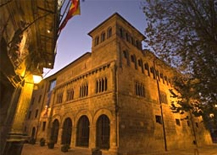
Locality: ESTELLA (31200)
Address: Calle San Nicolás, 1
Zone: The Central Zone
Website: www.museogustavodemaeztu.com
Style: Romanesque
Centuries of construction: XII
Tel.: 948546037
Email: info@museogustavodemaeztu.com
History
In Estella, in the square of San Martín, where the memory of this medieval city formerly populated by Franks and Jews still shines in all its splendour, stands the Palace of the Kings of Navarre, also known as the Palace of the Dukes of Granada de Ega.
It is the only civil Romanesque building in Navarre and was declared a National Monument in 1931 and was built during the last third of the 12th century.
Facing towards the church of San Pedro de la Rúa, it affords a magnificent façade with two narrative capitals, one of which represents the battle between Roland and the giant Farragut.
At present, it houses the Gustavo de Maeztu Museum. In the square of San Martín in Estella, occupying the corner with Calle de San Nicolás, on the Pilgrims’ Way, stands the Palace of the Kings of Navarre, one of the architectural treasures of the town of Estella and the only example of civil Romanesque in Navarre.
Description
The most important element of this rectangular-shaped building is its beautifully harmonious façade, structured in three sections and two towers. The lower section contains a gallery of four robust semicircular arches, while the second section is notable for its four large windows, each of which is divided by four smaller arches supported on slender columns with capitals. The upper section, which was enlarged in the 17th century, is a mansard of ashlars with three arrow slits, protected at the corners by two towers.
The façade is framed at each end by two columns superimposed with four beautiful capitals, two featuring plants and two narrative ones.
The lower capital of the left-hand column is the most famous of the two narrative capitals, in which you can clearly distinguish the battle between Roland and Farragut, the former being Charlemagne’s foremost knight and the latter a giant Moor. The capital shows the moment when the Christian hero defeated the Muslim by attacking him at his only weak spot, his navel.
In the column on the right, the upper capital contains two scenes with no connection between them. The left-hand side represents the fable of the donkey strumming a harp, listened to by a lion sat on his haunches, while on the right there are two misers from whose talons dangle money bags, walking towards their punishment and held in fetters. At their side, the condemned men are burned in a cauldron watched over by four devils.
The second section of the façade is topped by a velarium with a grille of rhomboids of canes, stalks and other plant themes, as well as scrolls, lobes, diamond points and a fish.
Following restoration work in 1975, the Palace became the venue for the Gustavo de Maeztu Museum (1887-1947) As well as paintings, watercolours, prints and sketches bequeathed to Estella by the painter from Vitoria, it also hosts temporary exhibitions and numerous courses and conferences.
Take advantage of your visit to the Palace to tour this town of medieval origin, following in the steps of the pilgrims and enjoying the artistic treasures of churches such as San Miguel and San Pedro de la Rúa.







